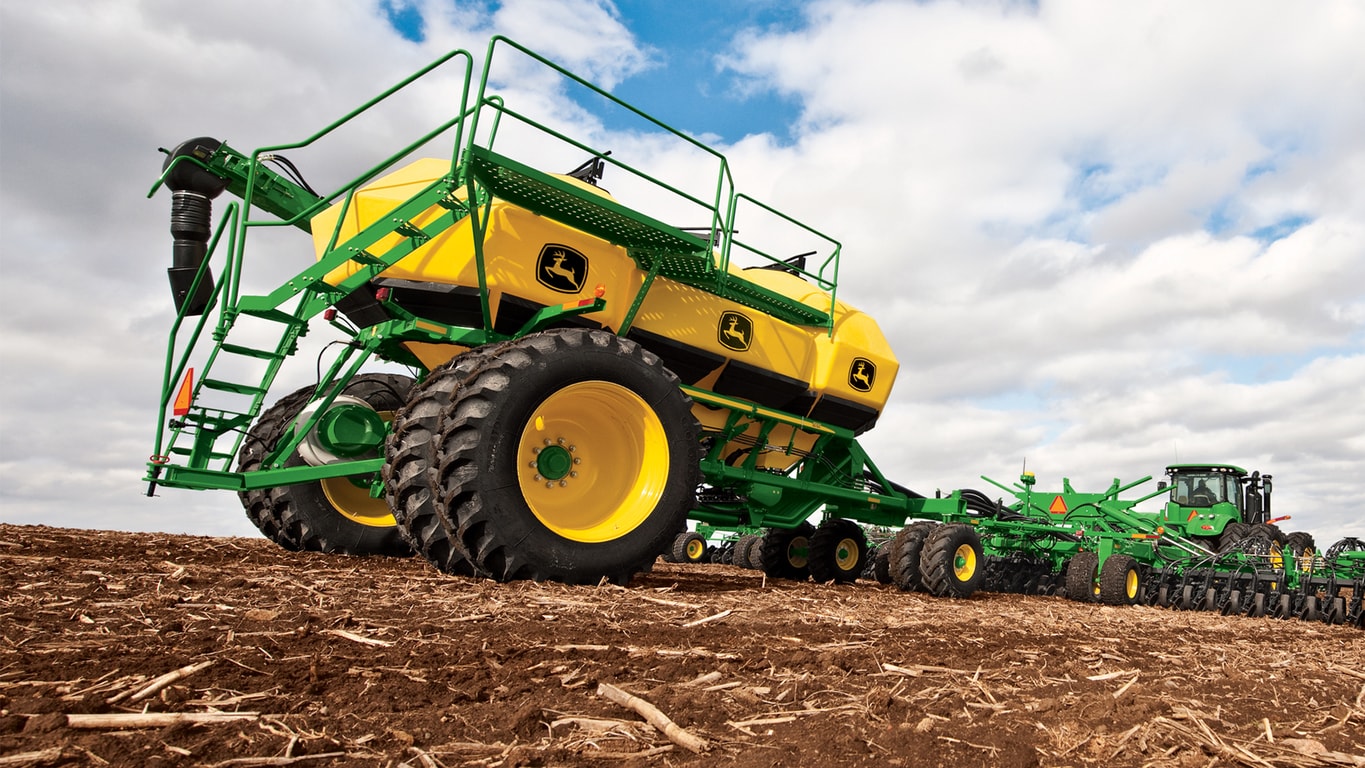
John Deere 1910
Tow-Behind Air Commodity Cart
- Choice of auger or conveyor
- Stationary single-shoot manifold
- In-line drive system transfers power efficiently
- New 550-bushel grain tank capacity on tow-behind models
Features
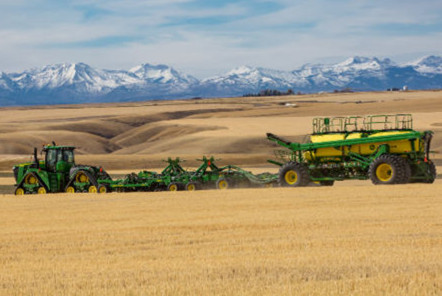
To win big in small grains, it takes a seeding solution that superseeds your expectations. John Deere delivers with a complete line of everything you need – and the sizes you want – to seed for success. Air-hoe drills. Commodity air carts. No-till air drills. Openers. Fertilizer attachments. Central commodity systems. Box drills. Plus precision ag technology to stretch your productivity to higher levels. But it’s far more than iron and technology. It’s the exceptional agronomic know-how and unsurpassed dealer support in all phases of production to keep you running. With our latest additions to equipment and openers, our seeding solutions deliver the next-generation performance you need to help you reach the full potential of each seed. That’s our commitment to you.
A meter cartridge at each tank effectively meters seed or fertilizer into the primary manifold. Air carries the material to the secondary distributor for delivery to the openers on the seeding tool.
Meters are contained in a cartridge for convenient removal and are color coded for easy identification.
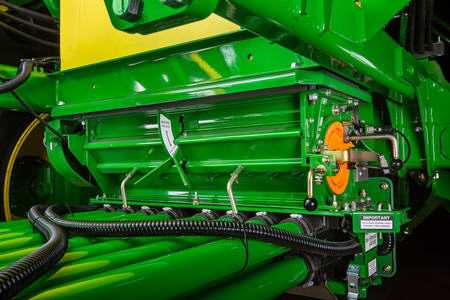 Metering system
Metering system
A manual half-width disconnect is incorporated into the meter system:
-
Allows one-half of the metering system to be manually shut off for irregular shaped headlands, point rows, etc. on mechanical drive carts.
- Allows the meter cartridge to be removed with material still in the tank(s).
- Allows tanks to be emptied with meter and primary manifold in place.
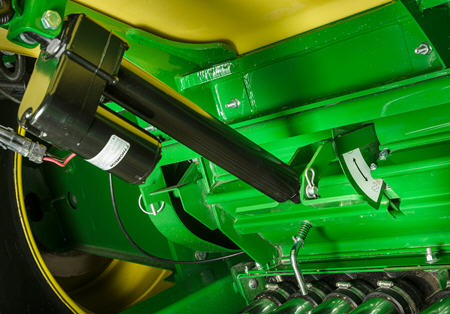 Electric actuator on C-Series Air Carts
Electric actuator on C-Series Air Carts
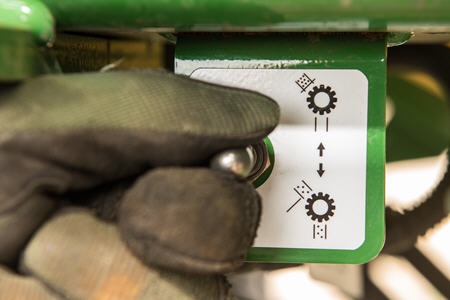
On the C-Series Air Carts, an electric actuator controls product flow from the tank to the meter housing:
- Allows complete shut off of product flow with little effort
- Allows the meter cartridge to be removed with material still in the tank(s)
- Allows tanks to be emptied with meter and primary manifold in place
With RelativeFlow Blockage sensing, operators can see the flow of both seed and fertilizer from inside the tractor cab. Sensors on all secondary hoses monitor the relative product flow row to row, giving you a better view of the flow rate of both seed and fertilizer from the cart to the opener from inside your tractor cab. This technology can help you identify any problems before a potential blockage occurs.
RelativeFlow Blockage is available in all run configurations on the following models (all widths):
- H500
- H500F
- P500
- P600
- N500
- N500F
- N500C
- 730LL
RelativeFlow Blockage is compatible with hydraulic drive carts: model year 2014 and newer 1910, all 19,381.5-L (550-bu) 1910 Carts, and C650 and C850 Air Carts.
Below are the Gen 4 display screens for the blockage monitoring system. For complete details and information, see the owner’s manual.
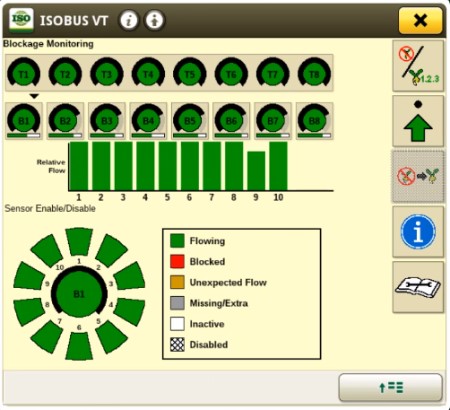 Blockage monitoring screen on Gen 4 display
Blockage monitoring screen on Gen 4 display
The RelativeFlow Blockage sensing chart shows the amount of flow through each sensor on the selected tower. Sensitivity for the blockage system can be adjusted if desired, as shown below.
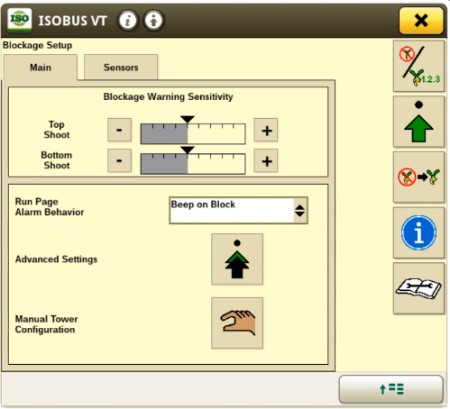 Blockage Setup screen on Gen 4 display
Blockage Setup screen on Gen 4 display
Blockage warning sensitivity allows the producer to set and change the sensitivity of the sensors to meet their preferences and varying crop/fertilizer types. Increasing the sensitivity means the system is more likely to show a false blockage, while less sensitivity means the system is more likely to miss a blockage.
Multiple run-page alarm behavior options are available for selection.
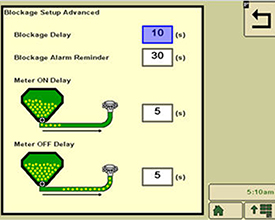 Blockage monitoring screen on Gen 4 display
Blockage monitoring screen on Gen 4 display
Below are the Gen 4 display screens for the blockage monitoring system on the N500C.
For complete details and information reference, the owner’s manual.
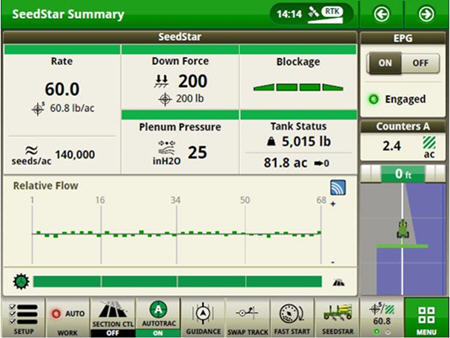 RelativeFlow Blockage configured run page
RelativeFlow Blockage configured run page
The SeedStar™ system run page displays the five major run settings. Clicking on any of the tiles will take an operator to that specific page (shown below).
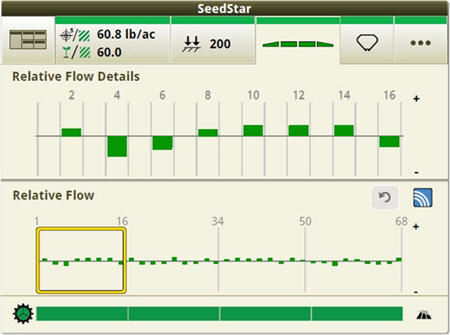 Operators can zoom into flow details by meter section when selecting blockage tiles
Operators can zoom into flow details by meter section when selecting blockage tiles
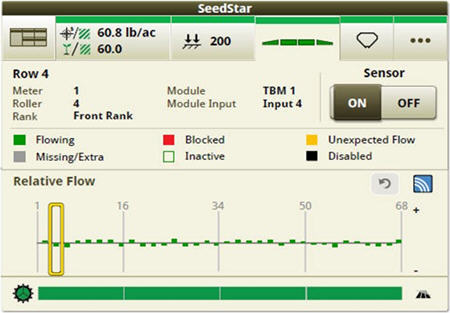 Operators can zoom into the row level to access row/sensor information and turn a sensor on/off independently
Operators can zoom into the row level to access row/sensor information and turn a sensor on/off independently
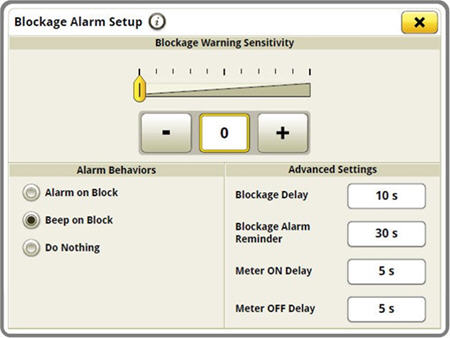 Blockage sensitivities and alarm delays are all set up on one easy-to-navigate screen
Blockage sensitivities and alarm delays are all set up on one easy-to-navigate screen
Blockage alarm delays can be set up by clicking on the advanced settings button from the blockage set-up screen.
- A blockage delay is how long a blockage should occur before an alarm is sounded.
- The blockage alarm reminder is how often the alarm should sound when a blockage occurs.
- The meter on delay is the time from when the meter is turned on until the blockage sensor should start monitoring for blockage.
- The meter off delay is the time from when the meter is turned off until the blockage sensor should start monitoring to verify no flow.
For more detailed information, see the owner’s manual.
Air tools with RelativeFlow Blockage are not compatible with 1910 air carts with ground drive.
SectionCommand is an effective, integrated, exclusive John Deere solution that reduces costly overlaps and skips that can waste seed and fertilizer, while offering more consistent fields that improve the potential of your yield and your bottom line.
Thanks to individual meter sections that control commodity flow, you can maintain the right application rates and row-to-row accuracy. This helps stimulate even crop emergence during the growing season and promotes consistent crop maturity at harvest. SectionCommand controls output from all meters on the cart up to eight sections.
Owner benefits include:
- Improved consistency of crop maturity at harvest
- Improved consistency during emergence and growing season
- Reduced seed input cost
- Reduced fertilizer input cost
- Increased time between fills due to input savings
SectionCommand is base equipment with optional deduct on all John Deere 1910 and C-Series Air Carts. Each tank and meter will receive SectionCommand components. A two-tank cart will control sections out of both tanks, a three-tank cart will control sections out of all three tanks, and the C-Series Air Carts will control sections out of all four tanks. SectionCommand is also available as an attachment for field conversion (AFC) for all 1910 hydraulic drive carts. See AFC kit story for more information.
SectionCommand controls seed and fertilizer output by closing and opening gates on the bottom side of the meter. When the gates are open, commodity is metered out, and when closed, commodity stays and continues to rotate within the meter. The meter stays full at all times so immediately when the gate opens, the commodity can flow into the primaries and out to the tool. Since each meter section has its own gate, application rates and row-to-row accuracy are not compromised. The gates are utilized to control commodity output on all sections. Once the last gate needs closed, the entire meter will stop turning, stopping product flow.
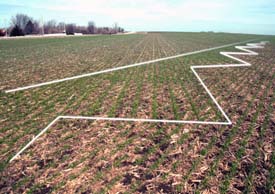 Seeded fields photo
Seeded fields photo

When commanded, electric over-hydraulic solenoids engage actuators to instantaneously close the gate for the needed section. The actuators are powered via hydraulics from the same circuit as the hydraulic drive motors. When power is cut, oil is diverted to retract the actuators and open the gates. The retraction is both powered and spring assisted, so it will always default to the seeding position. The oil from SectionCommand drains back through the fan motor case drain line and is coupled with an accumulator on the valve block to provide extra drainage capacity.
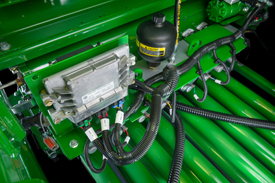 SectionCommand components as seen on back side of meter
SectionCommand components as seen on back side of meter
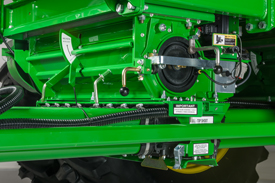 SectionCommand components as seen on front side of meter
SectionCommand components as seen on front side of meter
SectionCommand incorporates gate detection, which gives producers the satisfaction of knowing the gates are in position as commanded. Magnets on the back side of the gates are used in close proximity to the gate detection sensors to determine if the gates are open or closed. Should a gate not be in the commanded position, an alarm will alert the operator of the gate(s) in question. The blockage warning system works in conjunction with SectionCommand to give further confidence whether a given section is seeding or not when commanded.
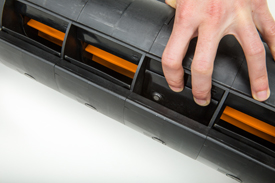 SectionCommand meter cartridge showing one gate closed and magnet on backside of gate
SectionCommand meter cartridge showing one gate closed and magnet on backside of gate
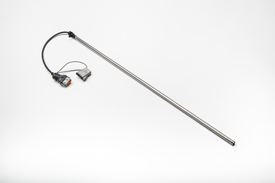 Gate detection sensor
Gate detection sensor
For maximum performance, SectionCommand should be controlled through John Deere Section Control. Coupling SectionCommand with John Deere Section Control provides the ultimate in precision seeding and productivity. If a Section Control activation is held by the producer, that same activation can be utilized for SectionCommand.
SectionCommand introduces the orange roller, which has the same number of flutes and spacing as the blue roller, but shorter flutes. It is for use only with SectionCommand when seeding seeds larger than 6 mm (0.25 in.) in diameter (soybeans, chick peas, etc.). The orange roller is not for use with cereal grains or fertilizer.
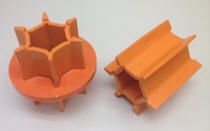 Orange roller for use only with large seeds and SectionCommand
Orange roller for use only with large seeds and SectionCommand
SectionCommand equalizer
Due to the varying lengths of product delivery hose used across the drill, SectionCommand has a built-in equalizer feature to ensure consistent product delivery across the width of the drill when entering and exiting headlands. The software allows the producer to set the on/off product delivery times separately for the outermost opener and the innermost opener on the drill. Product delivery times are inputted for each tank on the cart, and the software creates a time delay for actuation of the gates.
Please see the Using SectionCommand video for more information.
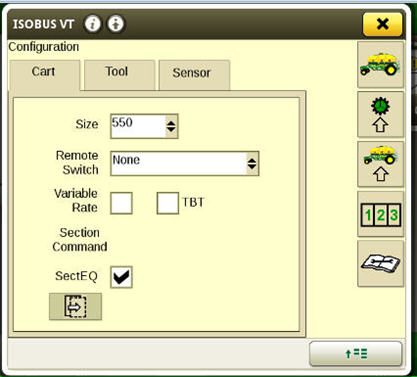 Enabling SectionCommand equalizer
Enabling SectionCommand equalizer
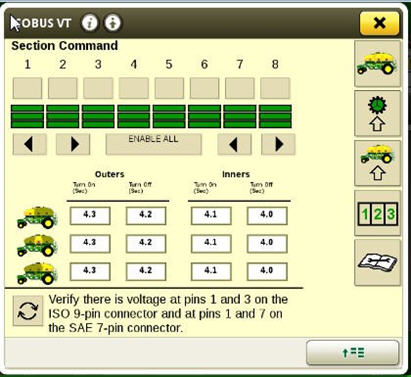 Input on/off times for outer opener versus inner opener on each tank
Input on/off times for outer opener versus inner opener on each tank
Secondary manifolds
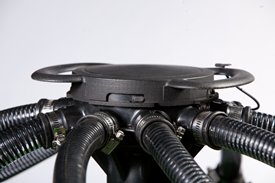 Secondary manifold on seeding tool
Secondary manifold on seeding tool
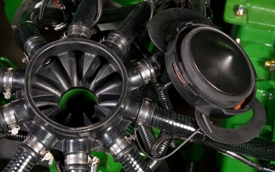 One-piece removable lid with tether
One-piece removable lid with tether
Secondary manifolds with 25-mm (1-in.) diameter lines evenly distribute the seed and/or fertilizer from the primary manifold(s) to the furrow openers.
Primary hoses are color coded to conveniently connect the air distribution kit from the 1910 Cart to the seeding tool.
The 25-mm (1-in.) secondary lines used for seed are clear with a black spiral. For double-shoot air kits, hoses are clear with a green spiral.
The secondary manifold is made of durable, maintenance-free ethylene-propylene molded (EPDM) rubber. Features of the secondary manifold:
- Rust resistant, important when applying fertilizer or treated seed
- No tools required to remove lid
- No long bolt in the secondary tower
- Lid is tethered to the manifold
- The outlet ports are numbered
- Primary hoses are color coded to conveniently connect
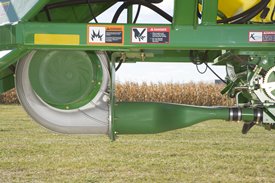 High-output, hydraulically driven fan
High-output, hydraulically driven fan
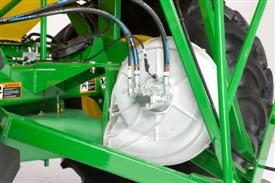 Fan as seen on 19,400-L (550-bu) cart
Fan as seen on 19,400-L (550-bu) cart
The 1910 Commodity Air Cart uses an airstream to gently deliver seed and/or fertilizer to the openers. A strong, consistent airstream is necessary to keep product moving without plugging the air runs, while making sure damage is not occurring to the seed.
The large 450-mm (17.6-in.) diameter fan generates a low-velocity, high-volume airstream that carries the product to the openers. By using a high volume of air, there is less chance of damaging seed, while decreasing the likelihood of plugging the air system.
The fan is driven by the tractor's hydraulic system. It requires approximately 53- to 75-L/min (14 to 26-gpm) oil flow for operation.
IMPORTANT: The 53- to 75-L/min (14- to 26-gpm) is for the 1910 Cart fan only; additional hydraulic capacity from the tractor is also required for the hydraulic drive motors and for the seeding tool, depending on what seeding tool is chosen.
NOTE: Requires motor seal drain kit.
Primary manifolds
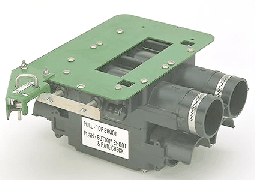 Stationary double-shoot primary manifold
Stationary double-shoot primary manifold

Primary manifolds are mounted below the tanks with 63.5-mm (2-1/2-in.) diameter tubes to distribute seed/fertilizer evenly to the secondary manifolds, which are located on the seeding tool.
63.5-mm (2-1/2-in.) primary lines are clear with either a black or green spiral:
-
Black spiral for single-shoot systems
-
Black and green spiral for double-shoot systems
Stationary single-shoot or stationary double-shoot primary manifolds are available.
Single-shoot air systems are used when seeding only or when applying a starter fertilizer along with the seed. Double-shoot air systems are used when applying higher levels of fertilizer, allowing simultaneous application of seed and fertilizer by placing them in two different locations in the seed row. With the proper 1910 Cart configuration, starter fertilizer can also be applied with the seed in a double-shoot air system.
Hydraulic drives
Starting in model year 2014, hydraulic drives became standard equipment on the 1910 air carts, offering consistent drive power to the meters. Hydraulic drives come standard with variable-rate drive and hydraulic calibration.
The drive system reduces a large number of mechanical and electrical components including transmissions, clutches, chain drives, sprockets, gears, and shafts by replacing them with a hydraulic drive motor, electrohydraulic valve, and a chain drive connecting the motor and meter.
Each meter has its own hydraulic drive motor and can be set independently of each other. It is recommended to use power beyond or another selective control valve (SCV) if power beyond is not available. Hydraulically powered meters minimize the pulsing effect found in chain driven systems. The motor speed is controlled by an electrohydraulic valve mounted on the motor.
Operators can shut off any meter from the in-cab display. The cart software comes with six pre-loaded rates for seeding. Map based prescriptions can be used with variable rates.
The system uses wheel speed from the cart to determine ground speed. If the cart wheel speed drops below 3.2 km/h (2 mph), the system will use tractor speed, if available, to maintain proper application rates when turning or coming out of a headland turn.
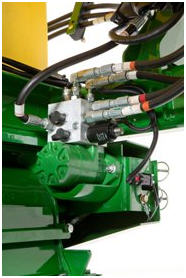 Hydraulic drive motor
Hydraulic drive motor

Variable rate
Starting in model year 2014, hydraulic variable-rate drive became standard equipment for 1910 air carts. Quick changing rates are important for maintaining accuracy with variable-rate prescription applications.
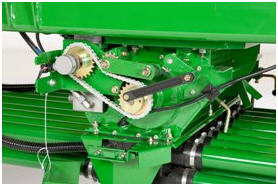 Meter drive system
Meter drive system
 Meter drive system with safety shield installed
Meter drive system with safety shield installed
Hydraulic calibration
Hydraulic calibration makes it convenient to rotate the cart meters to perform accurate calibration.
More than one meter can be calibrated at a time. Following the below instructions for 1910 air carts:
- Weigh bag, tare scale
- Add bag to bottom of meter
- Rotate the meters twice to charge them with product
- Turn the meters until they stop
- Weigh the bag with product inside
- Enter the weight of the product on the in-cab display
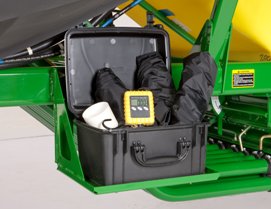 Calibration tools and equipment
Calibration tools and equipment
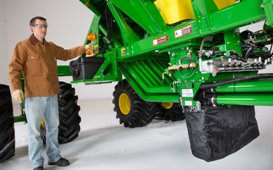 Operator performing calibration
Operator performing calibration
Meter verification
Operators can perform meter verification without driving. In the meter verification page on the in-cab display, select the meter(s) to verify and the stationary checkbox. When the operator engages the calibration switch, the meter will turn the number of revolutions to meter out the amount of product for the area selected.
NOTE: It is highly recommended to have power beyond and load sense installed on the tractor hydraulic system to power the hydraulic drives. This feature will save fuel, as well as reduce hydraulic heat, while providing maximum performance by the tractor hydraulic system to the cart hydraulic drive motors. By having load sense, the tractor is only required to provide the pressure and flow that the drives require. Power beyond and load sense capability have been tested and approved for all 8x00, 9x00, and newer John Deere tractors. Older John Deere tractors and competitive tractors have not been tested for functionality. If power beyond is not available, an additional SCV will be needed to power hydraulic drives. See link for more information on power beyond kits.
NOTE: Hydraulic drives cannot be performance upgraded onto mechanical drive carts.
NOTE: For high application rates, it is recommended to utilize tractors with the hi-flow hydraulic pump option. See 1910 Commodity Cart tractor compatibility and requirements for more information.
Operators continually seek easier and faster operations while seeding and reduce time spent filling and unloading.
Conveyance on 12,334-L (350-bu), 15,200-L (430-bu), and 19,400 (550-bu) carts is controlled by hydraulic cylinders on the conveyance arms. The cylinders move the main arm, swing arm, and elevation. Now operators can easily deploy the conveyance system with less effort.
Input to the system is received from one of two remotes. Each operator receives a wireless remote that can be operated from anywhere near the cart and a tethered remote that can be operated from ground level near the front meter. Each remote controls the same functions and gives flexibility of system control should two operators be in the area during cart fill and unload.
The remotes can start, stop, and control speed of the conveyance system. For added security, the speed control arm is retained on the conveyance and can override the remotes to slow down or stop the belt or auger.
Securing the auger or conveyor is now easier and gives the operator a greater sense of security with over-center latches on both the top and bottom of the conveyance.
Both the main and swing arms are longer giving operators greater flexibility in tendering vehicle parking locations.
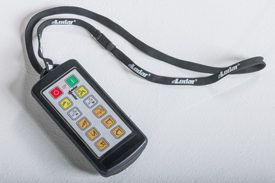 Wireless remote
Wireless remote
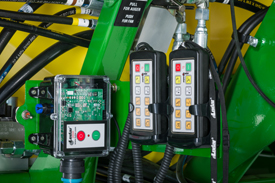 Receiver and tethered remote
Receiver and tethered remote

A - Remote on/off
B - Conveyance stop/start
C - Conveyance slow down/speed up
D - Tilt/elevation
E - Main arm retract/extend
F - Swing arm retract/extend
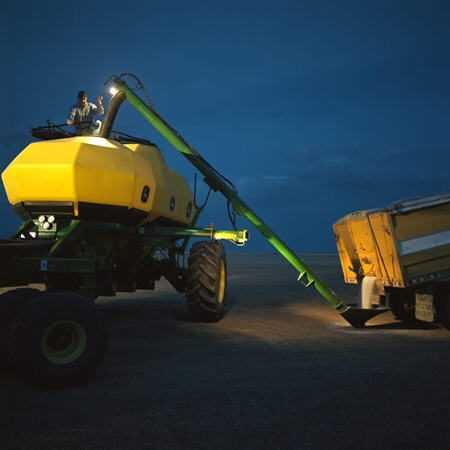 Factory-installed hopper
Factory-installed hopper
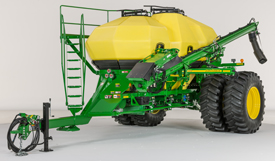 Left-hand side of cart in transport
Left-hand side of cart in transport
 Left-hand side of cart in fill position
Left-hand side of cart in fill position
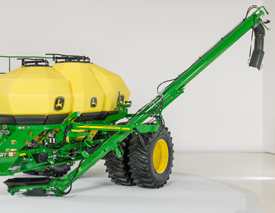 Left-hand side of cart in unload position
Left-hand side of cart in unload position
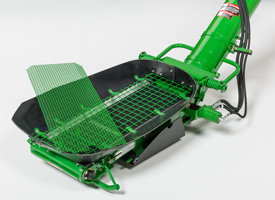 Low-profile hopper folder and unfolded
Low-profile hopper folder and unfolded
 Low-profile hopper folder and unfolded
Low-profile hopper folder and unfolded
Low-profile hopper
For operators who fill carts from semi hopper bottoms or who desire full width meter clean out, John Deere has partnered with KSi® Conveyors to provide a low-profile hopper. The hoppers are compatible with all hydraulic conveyance carts. The hoppers utilize conveyor belts and are available for both the 254-mm (10-in.) auger and 305-mm (12-in.) conveyor. The hoppers are longer than competitive offerings on similar cart sizes.
The hoppers easily fold over to keep mud and rocks from being slung into the hopper and for tight maneuverability during transport and seeding. During fill and unload, flip the hoppers back over to move product.
Each hopper comes with both a large and small screen for optimizing product flow and catching foreign material during fills. Rubber skirting around the hopper provides flexibility during use and adds capacity to the hopper.
Please contact KSi Conveyors for ordering information.
KSi Conveyors Inc.
c/o Bruce Frank
1(888) 574-3277
+1(815) 457-2403
jddealer@ksiconveyors.com
http://www.ksiconveyors.com/jddealer
KSi is a trademark of KSi Conveyor, Inc.
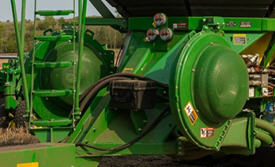 Air Power 2 fan drive system
Air Power 2 fan drive system
Enhanced air seeding performance would not be possible without the updates to the 15,152-L (430-bu) and 19,381-L (550-bu) 1910 and C850 air carts.
For the wider seeding width, more fan capacity has been added.
Air Power 2 provides two independently controlled fans – one for seed, one for fertilizer. Along with 76.2-mm (3-in.) primaries, more accurate delivery rates are possible across the full width of the seeding tool – from opener to opener. Air Power 2 delivers high rates, up to 40 percent more product delivery per primary compared to the single-fan system.
Dual fans are required for tow-between and tow-behind carts on the 23.2-m (76-ft) P576 and the 18.3-m (60-ft) N560F. Each fan will direct air to one set of primaries. Two selective control valves (SCVs) are required for the fans. The fan speed will be controlled through the SCV flow control.
Air Power 2 will also be compatible with:
- 17-m (56-ft) P556
- 13-m (43-ft) N543F
- 15.2- and 18.3-m (50- and 60-ft) 1890 models
An option is available for stainless-steel primaries to resist corrosion from high fertilizer rates.
 C850 Air Cart
C850 Air Cart
There is a slide at the meter to choose bottom or top shoot for each product. There is also a valve on the tank pressure system to choose top or bottom shoot. This same valve is used to adjust the amount of air to the tank to create the proper pressure differential.
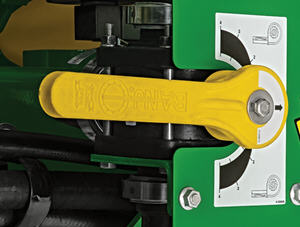 Pressure valve handle
Pressure valve handle
The arrow on the valve handle should be pointing to the top of the range for the top shoot and the bottom of the range for the bottom shoot. If the tank will not be in use, set the pressure valve to the middle setting to not pressurize the tank. The operator should use the gauge to find the correct setting. Location of pressure read-out:
- 1910 Tow-Behind left-hand side of cart on pressure gauge*
- 1910 Tow-Between front of the cart on pressure gauge*
- C850 Air Cart side display
* The electronic pressure sensor is located behind the mechanical gauge on the side of the cart.
For all Air Power 2 configured carts, an electronic pressure sensor will send a warning to the display if the tank pressure differential is out of range. If pressure is in the green operating range, the tanks are sealed and operating correctly.
Tank warnings on the GreenStar™ 3 2630 Display
NOTE: Only applies to 1910 AirPower 2 Carts as the C850 Cart is only compatible with the Gen 4 4600 CommandCenter™ or 4640 Universal Display.
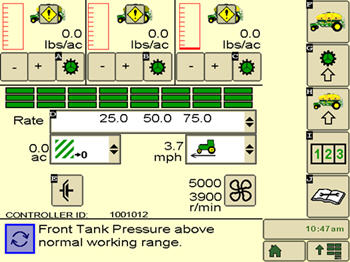 Tank warning on display
Tank warning on display
The operator will receive a warning in the display if a tank’s pressure is above or below normal working range. There will be a warning sign over the tank with the out-of-range issue.
Select the icon to view the tank pressure screen.
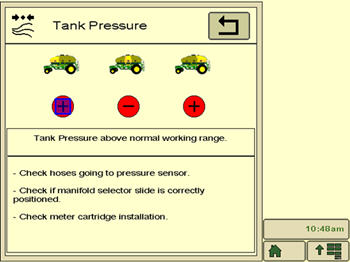 Tank pressure screen – plus indicates too much product
Tank pressure screen – plus indicates too much product
The operator can press on the red warning and get a screen that looks like the picture above. The plus indicates the pressure is out of range and could be delivering too much product.
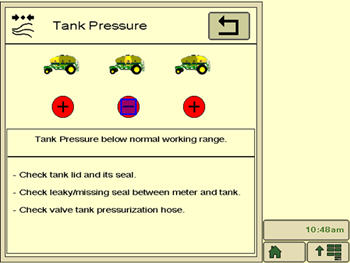 Tank pressure screen – minus indicate too little product
Tank pressure screen – minus indicate too little product
The minus indicates the pressure is out of range and could be delivering too little product.
*Only applies to 1910 Air Power 2 Carts as the C850 Cart is only compatible with the Gen 4 4600 CommandCenter™ or 4640 Universal Display.
NOTE: A quick reference guide will ship with every operator’s manual. Please reference that and the operator’s manual for more detailed information.
 254-mm (10-in.) auger on 15,200-L (430-bu) cart
254-mm (10-in.) auger on 15,200-L (430-bu) cart

As growers look for ways to increase efficiencies, one solution is to shorten the time required to fill. By increasing pit stop productivity, growers are able to cover more ground per day.
Producers have the choice of an auger or conveyor to fit their needs.
The 254-mm (10-in.) auger:
- Available on the 12,300-L (350-bu), 15,200-L (430-bu), and 19,400-L (550-bu) carts
- Loading rate 1800-L (50-bu) per minute
- Balanced for safe, convenient movement between storage and filling positions
- Able to fit under the meters for tank cleanout
The 203-mm (8-in.) auger:
- Available on 8,800-L (250-bu), 9,500-L (270-bu), and 12,000-L (340-bu) carts
- 700-L (20-bu) per minute fill rate
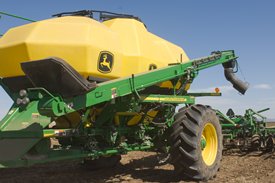 305-mm (12-in.) conveyor
305-mm (12-in.) conveyor

The 305-mm (12-in.) conveyor provides producers with a gentle conveyance system:
- 305-mm (12-in.) wide belt with risers spaced on 150-mm (6-in.)
- 1400-L (40-bu) per minute fill rate
- Can also transfer fertilizer
- Cleanout trap door at the bottom
- Optional on all 1910 carts
The telescoping spout provides the following benefits:
- Decreases fill time
- Easily fills each tank to the very top
- Improves movement when going from one tank to another, matching the tank height
SectionCommand is available as an attachment for field conversion (AFC) for all hydraulic drive carts. See SectionCommand saves seed and fertilizer input costs for more information on benefits and workings of the system.
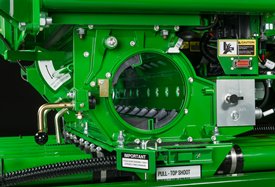 SectionCommand components on 1910 Cart with meter cartridge removed
SectionCommand components on 1910 Cart with meter cartridge removed
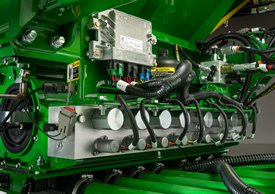 SectionCommand on 1910 Air Cart
SectionCommand on 1910 Air Cart
There are four main components needed to add SectionCommand onto 1910 hydraulic drive air carts:
1. SectionCommand AFC kit (listed in the table below, order one kit per meter), kit includes:
- SectionCommand valve block and meter housing components
- Gate detection controller
- Electronic power module (EPM)
- Associated harnessing, hardware, and brackets
2. Hydraulic hoses - Dealer is responsible for fabricating and sourcing hoses.
3. SectionCommand meter cartridges will be needed for each meter. These meter cartridges contain gates, gate detection sensors, and a secondary meter lock-down. See Meter cartridges for field conversion for more information.
4. New Operator’s Manual including SectionCommand. Order A98462 or newer 1910 operator’s manual when installing onto a model year 2013 19,400-L (550-bu) cart or all model year 2014 carts.
Ensure the latest version of software is installed on both cart controller and in-cab display.
All SectionCommand kits are sold in eight-run configurations. If pairing the cart with a tool of seven runs or less, order one - BA32812 meter run reduction kit per cart. This kit contains parts to block off runs not used when pairing a cart with a tool of seven runs or less.
NOTE: For SectionCommand to operate properly, it must be installed on each meter.
Growers around the world are always looking for ways to become more productive. The John Deere Seeding Group is continually looking for ways to help these growers increase productivity.
The 1910 Commodity Cart is one of the best ways to maximize productivity. By providing growers with several different tank configurations, the 1910 Cart allows growers to get the most benefit from input costs and time in the field.
The tanks are a semi-transparent, poly material. Owner benefits include:
- Corrosion resistance
- Ease of quickly viewing tank level from outside the cart
- Lightweight, increasing cart floatation
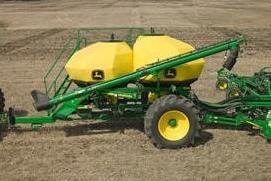 Large-capacity, two-tank 1910
Large-capacity, two-tank 1910
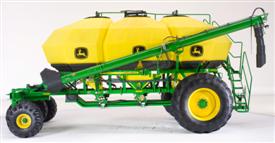 Three tanks increase productivity and efficiency
Three tanks increase productivity and efficiency
Tow-behind capacity |
|||||||
Two tanks |
Total |
||||||
Bushel |
270 |
120 |
150 |
|
|
||
Litres |
9500 |
4200 |
5300 |
|
|||
Tonnes |
7.2 |
3.2 |
4.0 |
|
|||
Bushel |
350 |
150 |
200 |
|
|
||
Litres |
12,300 |
5300 |
7000 |
|
|||
Tonnes |
9.4 |
4.0 |
5.4 |
|
|||
Three tanks |
Total |
||||||
Bushel |
340 |
120 |
70 |
150 |
|
||
Litres |
12,000 |
4200 |
2500 |
5300 |
|||
Tonnes |
9.1 |
3.2 |
1.9 |
4.0 |
|||
Bushel |
430 |
150 |
80 |
200 |
|
||
Litres |
15,200 |
5300 |
2800 |
7000 |
|||
Tonnes |
11.5 |
4.0 |
2.1 |
5.4 |
|||
Bushel |
550 |
200 |
150* |
200 |
 |
||
Litres |
19,400 |
7000 |
5300 |
7000 |
|||
Tonnes |
17.2 |
5.4 |
4.0 |
5.4 |
|||
Tow-between capacity |
|||||||
Two tanks |
Total |
||||||
Bushel |
270 |
120 |
150 |
|
|
||
Litres |
9500 |
4200 |
5300 |
|
|||
Tonnes |
7.2 |
3.2 |
4.0 |
|
|||
Bushel |
350 |
150 |
200 |
|
|
||
Litres |
12,300 |
5300 |
7000 |
|
|||
Tonnes |
9.4 |
4.0 |
5.4 |
|
|||
Three tanks |
Total |
||||||
Bushel |
430 |
150 |
80 |
200 |
|
||
Litres |
15,200 |
5300 |
2800 |
7000 |
|||
Tonnes |
11.5 |
4.0 |
2.1 |
5.4 |
|||
*Assumptions: cubic meter (1000 litres) of: wheat (front tank) = 0.76 tonnes, urea (middle tank) = 0.73 tonnes, fertilizer (rear tank) = 1.10 tonnes, bushel = 35.3 litres.
The tank lids are sealed, ensuring proper air pressure within the tank and at the meters. Sealing the tanks improves hydraulic fan utilization, providing efficient and optimum seeding accuracy.
With less than 0.13 bar (2 psi) of pressure in the tank, the pressure is equalized between the meters and tanks, providing an accurate, consistent seeding rate.
NOTE: Tank volume is measured to heaped capacity. When product is shoveled to the corners of the tank, the tanks may hold more than advertised capacity.
Specs & Compare
Key Specs | 1910 Current Model |
| Sizes - Tow-between model | 2-tank 270, 350 bu 9531, 12355 L 3-tank 250, 430 bu 8826, 15179 L |
| Sizes - Tow-behind model | 2-tank 270, 350 bu 9531, 12355 L 3-tank 250, 340, 430, 550 bu 8810, 12002, 15179, 19381 L |
| Fan size | 44.7 (single), 66.04 (dual) cm 17.6 (single), 26 (dual) in. |
| Fan speed | 2000 to 5000 rpm |
| Meter rolls | Up to 8 individual meter segments |
| Meter settings | Infinitely variable 0-265 lb per acre |
Sizes | |
| Tow-between model | 2-tank 270, 350 bu 9531, 12355 L 3-tank 250, 430 bu 8826, 15179 L |
| Tow-behind model | 2-tank 270, 350 bu 9531, 12355 L 3-tank 250, 340, 430, 550 bu 8810, 12002, 15179, 19381 L |
Fan | |
| Type | Hydraulic motor, 26.5 USGPM @ 5000 psi max. |
| Size | 44.7 (single), 66.04 (dual) cm 17.6 (single), 26 (dual) in. |
| Speed | 2000 to 5000 rpm |
Meter drives | |
| Type | Drive shaft |
| Variable rate drive | Mechanical |
| Variable rate control | Electric |
| Limp home mode | Yes |
Tanks | |
| Type | Translucent polyethylene |
| Lids | Diameter Round: 67.31 cm Diameter Round: 26.5 in. |
| Open-lid indicators | Standard equipment |
Meters | |
| Meter rolls | Up to 8 individual meter segments |
| Identify | Color-coded meter rollers |
| Settings | Infinitely variable 0-265 lb per acre |
| Half-width disconnect | Yes |
| Fine-tuning rings | Yes |
Monitor | |
Conveyance | |
Tires | |
| Rear wheels and tires | All-weather turf tread (standard) |
| Front wheels and tires | |
Ergonomics | |
| Access | Staircase with railing |
| Fill lights | Standard |
Freight | |
Additional information | |
Offers & Discounts
Accessories & Attachments
Miscellaneous
Kits for conveyance systems
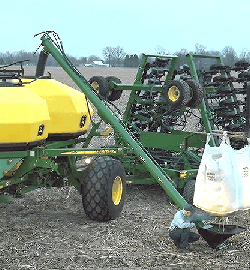 1910 Cart auger
1910 Cart auger
Choose from two options when selecting the conveyance system for the 1910 Commodity Air Cart. Choose between an auger or conveyor. Fill time is less than 15 minutes and unloading time is less than 10 minutes. The lighting system at the hitch alerts the operator as to when the tank product levels are approaching full during a fill.
The auger is available with steel or brush flighting on all sizes, or cupped, to gently handle seed, which is available on the 8-inch auger only. These conveyance systems are recommended for beans and legumes, but not fertilizers.
NOTES:
-
Hydraulic hose kit may be required. If cart was originally ordered less auger (Option code 4595), then hydraulic hose kit is required. For more information on hydraulic hose kits for conveyance systems, please consult: conveyance hydraulic hose attachments
-
Conveyance swing arm system may be required. When adding a conveyor to a 1900 Cart OR to a 1910 Cart prior to serial numbers (A01910T700346 Tow-Between or A01910H700409 Tow-Behind), an arm system is required. When adding an auger attachment to a 1900 Cart or 1910 Cart prior to serial numbers (A01910T700346 tow-hetween or A01910H700409 Tow-Behind), an arm system is required due to changes in latching system. Tow-between 1910 Carts above serial number (A01910T700346) and tow-behind carts above serial number (A01910H700409) do not require updates to arm system. Please consult conveyance arm attachments for additional ordering information.
-
All 7-in. and 8-in. auger attachments require A60206 auger hopper from Service Parts.
-
7-in. and 8-in. augers do not include downspouts. For a 7-in., flexible downspout, order (1)A61684 tube and (2) TY22495 clamps from Service Parts. For a 8-in. flexible downspout, order (1) A60207 tube and (2) TY22497 clamps from Service Parts. For a telescopic spout for 8-in. augers, please consult telescoping spout attachments for field conversion. 12-in. conveyors have a telescopic spout included in the bundle as standard equipment.
Swing arm kit
 1910 Cart auger
1910 Cart auger
The swing link arm allows for better movement with the redesigned pivot. It has a larger ''sweet spot'' for easier movement and placement of the hopper.
- NOTE: Required if cart was previously ordered without an auger/conveyor system (code 4595).
Swing arm kit
 1910 Cart auger
1910 Cart auger
The swing link arm allows for better movement with the redesigned pivot. It has a larger ''sweet spot'' for easier movement and placement of the hopper.
- NOTE: Required if cart was previously ordered without an auger/conveyor system (code 4595).
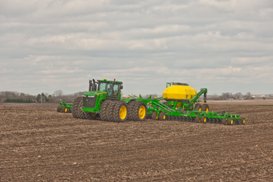 TBH cart with tool and tractor
TBH cart with tool and tractor

See link below for information on seeding tool and TBH cart compatibility.
1910 Tow-Behind Cart and seeding tool compatibility
See link below for information on hydraulic, electrical, and software requirements for pairing hydraulic drive carts with model year 2013 and older seeding tools.
Hydraulic drive cart requirements for software, hydraulic and electrical overlays
The following table outlines hydraulic hose overlay AFC kits available for:
- Power beyond, return, and load sense for hydraulic drive and SectionCommand™
- Fan power, return, and case drain
All model year 2014 and newer tools paired with TBH carts are shipped from the factory with overlay hoses for both number’s one and two from above.
Model 2013 and older tools did not have power beyond, return, and load sense hoses installed except for when paired with a 550 bu TBH cart. If pairing a model year 2013 or older tool with a TBH cart, hoses for power beyond, return, and load sense will need installed and can be seen below.
 TBH cart with tool and tractor
TBH cart with tool and tractor

See link below for information on seeding tool and TBH cart compatibility.
1910 Tow-Behind Cart and seeding tool compatibility
See link below for information on hydraulic, electrical, and software requirements for pairing hydraulic drive carts with model year 2013 and older seeding tools.
Hydraulic drive cart requirements for software, hydraulic and electrical overlays
The following table outlines hydraulic hose overlay AFC kits available for:
- Power beyond, return, and load sense for hydraulic drive and SectionCommand™
- Fan power, return, and case drain
All model year 2014 and newer tools paired with TBH carts are shipped from the factory with overlay hoses for both number’s one and two from above.
Model 2013 and older tools did not have power beyond, return, and load sense hoses installed except for when paired with a 550 bu TBH cart. If pairing a model year 2013 or older tool with a TBH cart, hoses for power beyond, return, and load sense will need installed and can be seen below.
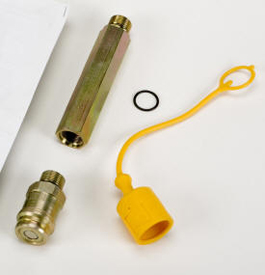 Flush face case drain coupler
Flush face case drain coupler
For installing tractor case drain for vacuum motors. A motor seal drain kit (return to sump) protects the motor and shaft seal by allowing motor housing pressure to return back to hydraulic reservoir free of any back pressure. Handles up to 3 U.S. gallons per minute.
NOTE: All vacuum planters built after 1 May 2004 have hydraulic case drain vacuum motors. These motors have a flush-face case drain hose tip on the return oil line that must be routed to the tractor's sump/case drain port. The tractor requires a case drain coupler be installed in this port to accept the return hose.
This kit is required for operation of 1910 Commodity Air Cart and 1990 CCSTM hydraulically-driven fan.
 Flush face case drain coupler
Flush face case drain coupler
For installing tractor case drain for vacuum motors. A motor seal drain kit (return to sump) protects the motor and shaft seal by allowing motor housing pressure to return back to hydraulic reservoir free of any back pressure. Handles up to 3 U.S. gallons per minute.
NOTE: All vacuum planters built after 1 May 2004 have hydraulic case drain vacuum motors. These motors have a flush-face case drain hose tip on the return oil line that must be routed to the tractor's sump/case drain port. The tractor requires a case drain coupler be installed in this port to accept the return hose.
This kit is required for operation of 1910 Commodity Air Cart and 1990 CCSTM hydraulically-driven fan.
 TBH cart with tool and tractor
TBH cart with tool and tractor

See link below for information on seeding tool and TBH cart compatibility.
1910 Tow-Behind Cart and seeding tool compatibility
See link below for information on hydraulic, electrical, and software requirements for pairing hydraulic drive carts with model year 2013 and older seeding tools.
Hydraulic drive cart requirements for software, hydraulic and electrical overlays
The following table outlines hydraulic hose overlay AFC kits available for:
- Power beyond, return, and load sense for hydraulic drive and SectionCommand™
- Fan power, return, and case drain
All model year 2014 and newer tools paired with TBH carts are shipped from the factory with overlay hoses for both number’s one and two from above.
Model 2013 and older tools did not have power beyond, return, and load sense hoses installed except for when paired with a 550 bu TBH cart. If pairing a model year 2013 or older tool with a TBH cart, hoses for power beyond, return, and load sense will need installed and can be seen below.
 TBH cart with tool and tractor
TBH cart with tool and tractor

See link below for information on seeding tool and TBH cart compatibility.
1910 Tow-Behind Cart and seeding tool compatibility
See link below for information on hydraulic, electrical, and software requirements for pairing hydraulic drive carts with model year 2013 and older seeding tools.
Hydraulic drive cart requirements for software, hydraulic and electrical overlays
The following table outlines hydraulic hose overlay AFC kits available for:
- Power beyond, return, and load sense for hydraulic drive and SectionCommand™
- Fan power, return, and case drain
All model year 2014 and newer tools paired with TBH carts are shipped from the factory with overlay hoses for both number’s one and two from above.
Model 2013 and older tools did not have power beyond, return, and load sense hoses installed except for when paired with a 550 bu TBH cart. If pairing a model year 2013 or older tool with a TBH cart, hoses for power beyond, return, and load sense will need installed and can be seen below.
There are five types of meter cartridges available to match seed and fertilizer types and rates.
Low rate
 Low-rate meter roller
Low-rate meter roller
The yellow, low-rate meter roller is for rates from 0.91 up to 9.07 kg/ha (2 up to 20 lb/acre) for seeds such as flax, canola, and alfalfa. The low-rate meter roller rotates more continuously, minimizing pulsing effect for better metering at low rates. There are 20 flutes on this meter roller. Each flute is 8-mm (0.31-in.) wide at the top, 2-mm (0.08-in.) wide at the bottom, and 1.5-mm (0.06-in.) deep.
Medium rate
 Medium-rate meter roller
Medium-rate meter roller
The black medium-rate meter roller is for rates from 9.07 up to 59 kg/ha (20 up to 130 lb/acre) for seeds such as wheat, barley, canola, and small soybeans up to 6.35 mm (0.25 in.) in diameter. It is also used for medium rates of fertilizer. This is the most commonly used meter roller. There are 10 flutes on this roller, which are 18.5-mm (0.73-in.) wide at the top of the flute, 12-mm (0.47-in.) at the bottom of the flute, and 8-mm (0.31-in.) deep.
High rate
 High-rate meter roller
High-rate meter roller
The green, high-rate meter roller is for rates from 30 up to 99.8 kg/ha (220 lb/acre), such as high rates of fertilizer and large soybeans bigger than 6.35 mm (0.25 in.) in diameter. There are 10 flutes, which are deeper and wider. Each flute is 21.5-mm (0.85 in.) wide at the top of the flute, 8-mm (0.31-in.) wide at the bottom of the flute, and 14-mm (0.55-in.) deep.
Very high rate
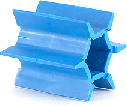 Very high-rate meter roller
Very high-rate meter roller
This blue roller is for rates from 22.7-120.2 kg/ha (50-265 lb/acre), or seeds such as barley and oats with beards. It is also used for large seeds such as garbanzo beans (in non SectionCommand™ system applications) or very high fertilizer rates. There are six flutes, which are very deep and widely spaced.
Large-seed roller for SectionCommand control system
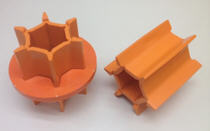 Large seed meter roller
Large seed meter roller

- For use with large seeds only (6 mm [0.25 in.] in diameter or larger)
- For use with SectionCommand only
- Is not for use with fertilizers or cereal grains
- Preserves seed quality of large seeds when used with SectionCommand
The width of the seeding tool and the number of furrow openers determine the number of active primary ports. The commodity cart can be equipped with a 3, 4, 5, 6, 7, or 8-run meter roller. One meter roller is required for each tank on the 1910.
When outfitting a cart with SectionCommand, new SectionCommand meter cartridges with gates and gate detection equipment will be needed. SectionCommand is sold in eight-run only configurations. In order to utilize SectionCommand on carts paired with tools less than eight runs, primary reduction kits are available. See table below for more information.
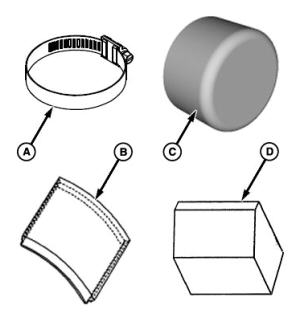 Primary reduction kit
Primary reduction kit
Open or close product runs – C850 Air Cart
NOTE: The following procedure aligns the air cart meter with the seeding tool.
Part identification:
A. Hose clamp
B. Meter cover
C. Cap, 76.2 mm (3 in.) ID
D. Meter seal
NOTE: When metering high rates through a seeding tool with three to four secondary manifolds, it may be necessary to either add secondary manifolds or slow down to achieve a very high target rate.
There are five types of meter cartridges available to match seed and fertilizer types and rates.
Low rate
 Low-rate meter roller
Low-rate meter roller
The yellow, low-rate meter roller is for rates from 0.91 up to 9.07 kg/ha (2 up to 20 lb/acre) for seeds such as flax, canola, and alfalfa. The low-rate meter roller rotates more continuously, minimizing pulsing effect for better metering at low rates. There are 20 flutes on this meter roller. Each flute is 8-mm (0.31-in.) wide at the top, 2-mm (0.08-in.) wide at the bottom, and 1.5-mm (0.06-in.) deep.
Medium rate
 Medium-rate meter roller
Medium-rate meter roller
The black medium-rate meter roller is for rates from 9.07 up to 59 kg/ha (20 up to 130 lb/acre) for seeds such as wheat, barley, canola, and small soybeans up to 6.35 mm (0.25 in.) in diameter. It is also used for medium rates of fertilizer. This is the most commonly used meter roller. There are 10 flutes on this roller, which are 18.5-mm (0.73-in.) wide at the top of the flute, 12-mm (0.47-in.) at the bottom of the flute, and 8-mm (0.31-in.) deep.
High rate
 High-rate meter roller
High-rate meter roller
The green, high-rate meter roller is for rates from 30 up to 99.8 kg/ha (220 lb/acre), such as high rates of fertilizer and large soybeans bigger than 6.35 mm (0.25 in.) in diameter. There are 10 flutes, which are deeper and wider. Each flute is 21.5-mm (0.85 in.) wide at the top of the flute, 8-mm (0.31-in.) wide at the bottom of the flute, and 14-mm (0.55-in.) deep.
Very high rate
 Very high-rate meter roller
Very high-rate meter roller
This blue roller is for rates from 22.7-120.2 kg/ha (50-265 lb/acre), or seeds such as barley and oats with beards. It is also used for large seeds such as garbanzo beans (in non SectionCommand™ system applications) or very high fertilizer rates. There are six flutes, which are very deep and widely spaced.
Large-seed roller for SectionCommand control system
 Large seed meter roller
Large seed meter roller

- For use with large seeds only (6 mm [0.25 in.] in diameter or larger)
- For use with SectionCommand only
- Is not for use with fertilizers or cereal grains
- Preserves seed quality of large seeds when used with SectionCommand
The width of the seeding tool and the number of furrow openers determine the number of active primary ports. The commodity cart can be equipped with a 3, 4, 5, 6, 7, or 8-run meter roller. One meter roller is required for each tank on the 1910.
When outfitting a cart with SectionCommand, new SectionCommand meter cartridges with gates and gate detection equipment will be needed. SectionCommand is sold in eight-run only configurations. In order to utilize SectionCommand on carts paired with tools less than eight runs, primary reduction kits are available. See table below for more information.
 Primary reduction kit
Primary reduction kit
Open or close product runs – C850 Air Cart
NOTE: The following procedure aligns the air cart meter with the seeding tool.
Part identification:
A. Hose clamp
B. Meter cover
C. Cap, 76.2 mm (3 in.) ID
D. Meter seal
NOTE: When metering high rates through a seeding tool with three to four secondary manifolds, it may be necessary to either add secondary manifolds or slow down to achieve a very high target rate.
There are five types of meter cartridges available to match seed and fertilizer types and rates.
Low rate
 Low-rate meter roller
Low-rate meter roller
The yellow, low-rate meter roller is for rates from 0.91 up to 9.07 kg/ha (2 up to 20 lb/acre) for seeds such as flax, canola, and alfalfa. The low-rate meter roller rotates more continuously, minimizing pulsing effect for better metering at low rates. There are 20 flutes on this meter roller. Each flute is 8-mm (0.31-in.) wide at the top, 2-mm (0.08-in.) wide at the bottom, and 1.5-mm (0.06-in.) deep.
Medium rate
 Medium-rate meter roller
Medium-rate meter roller
The black medium-rate meter roller is for rates from 9.07 up to 59 kg/ha (20 up to 130 lb/acre) for seeds such as wheat, barley, canola, and small soybeans up to 6.35 mm (0.25 in.) in diameter. It is also used for medium rates of fertilizer. This is the most commonly used meter roller. There are 10 flutes on this roller, which are 18.5-mm (0.73-in.) wide at the top of the flute, 12-mm (0.47-in.) at the bottom of the flute, and 8-mm (0.31-in.) deep.
High rate
 High-rate meter roller
High-rate meter roller
The green, high-rate meter roller is for rates from 30 up to 99.8 kg/ha (220 lb/acre), such as high rates of fertilizer and large soybeans bigger than 6.35 mm (0.25 in.) in diameter. There are 10 flutes, which are deeper and wider. Each flute is 21.5-mm (0.85 in.) wide at the top of the flute, 8-mm (0.31-in.) wide at the bottom of the flute, and 14-mm (0.55-in.) deep.
Very high rate
 Very high-rate meter roller
Very high-rate meter roller
This blue roller is for rates from 22.7-120.2 kg/ha (50-265 lb/acre), or seeds such as barley and oats with beards. It is also used for large seeds such as garbanzo beans (in non SectionCommand™ system applications) or very high fertilizer rates. There are six flutes, which are very deep and widely spaced.
Large-seed roller for SectionCommand control system
 Large seed meter roller
Large seed meter roller

- For use with large seeds only (6 mm [0.25 in.] in diameter or larger)
- For use with SectionCommand only
- Is not for use with fertilizers or cereal grains
- Preserves seed quality of large seeds when used with SectionCommand
The width of the seeding tool and the number of furrow openers determine the number of active primary ports. The commodity cart can be equipped with a 3, 4, 5, 6, 7, or 8-run meter roller. One meter roller is required for each tank on the 1910.
When outfitting a cart with SectionCommand, new SectionCommand meter cartridges with gates and gate detection equipment will be needed. SectionCommand is sold in eight-run only configurations. In order to utilize SectionCommand on carts paired with tools less than eight runs, primary reduction kits are available. See table below for more information.
 Primary reduction kit
Primary reduction kit
Open or close product runs – C850 Air Cart
NOTE: The following procedure aligns the air cart meter with the seeding tool.
Part identification:
A. Hose clamp
B. Meter cover
C. Cap, 76.2 mm (3 in.) ID
D. Meter seal
NOTE: When metering high rates through a seeding tool with three to four secondary manifolds, it may be necessary to either add secondary manifolds or slow down to achieve a very high target rate.
There are five types of meter cartridges available to match seed and fertilizer types and rates.
Low rate
 Low-rate meter roller
Low-rate meter roller
The yellow, low-rate meter roller is for rates from 0.91 up to 9.07 kg/ha (2 up to 20 lb/acre) for seeds such as flax, canola, and alfalfa. The low-rate meter roller rotates more continuously, minimizing pulsing effect for better metering at low rates. There are 20 flutes on this meter roller. Each flute is 8-mm (0.31-in.) wide at the top, 2-mm (0.08-in.) wide at the bottom, and 1.5-mm (0.06-in.) deep.
Medium rate
 Medium-rate meter roller
Medium-rate meter roller
The black medium-rate meter roller is for rates from 9.07 up to 59 kg/ha (20 up to 130 lb/acre) for seeds such as wheat, barley, canola, and small soybeans up to 6.35 mm (0.25 in.) in diameter. It is also used for medium rates of fertilizer. This is the most commonly used meter roller. There are 10 flutes on this roller, which are 18.5-mm (0.73-in.) wide at the top of the flute, 12-mm (0.47-in.) at the bottom of the flute, and 8-mm (0.31-in.) deep.
High rate
 High-rate meter roller
High-rate meter roller
The green, high-rate meter roller is for rates from 30 up to 99.8 kg/ha (220 lb/acre), such as high rates of fertilizer and large soybeans bigger than 6.35 mm (0.25 in.) in diameter. There are 10 flutes, which are deeper and wider. Each flute is 21.5-mm (0.85 in.) wide at the top of the flute, 8-mm (0.31-in.) wide at the bottom of the flute, and 14-mm (0.55-in.) deep.
Very high rate
 Very high-rate meter roller
Very high-rate meter roller
This blue roller is for rates from 22.7-120.2 kg/ha (50-265 lb/acre), or seeds such as barley and oats with beards. It is also used for large seeds such as garbanzo beans (in non SectionCommand™ system applications) or very high fertilizer rates. There are six flutes, which are very deep and widely spaced.
Large-seed roller for SectionCommand control system
 Large seed meter roller
Large seed meter roller

- For use with large seeds only (6 mm [0.25 in.] in diameter or larger)
- For use with SectionCommand only
- Is not for use with fertilizers or cereal grains
- Preserves seed quality of large seeds when used with SectionCommand
The width of the seeding tool and the number of furrow openers determine the number of active primary ports. The commodity cart can be equipped with a 3, 4, 5, 6, 7, or 8-run meter roller. One meter roller is required for each tank on the 1910.
When outfitting a cart with SectionCommand, new SectionCommand meter cartridges with gates and gate detection equipment will be needed. SectionCommand is sold in eight-run only configurations. In order to utilize SectionCommand on carts paired with tools less than eight runs, primary reduction kits are available. See table below for more information.
 Primary reduction kit
Primary reduction kit
Open or close product runs – C850 Air Cart
NOTE: The following procedure aligns the air cart meter with the seeding tool.
Part identification:
A. Hose clamp
B. Meter cover
C. Cap, 76.2 mm (3 in.) ID
D. Meter seal
NOTE: When metering high rates through a seeding tool with three to four secondary manifolds, it may be necessary to either add secondary manifolds or slow down to achieve a very high target rate.
Contact a John Deere dealer for information on primary run air packages for noncurrent seeding tools.
Contact a John Deere dealer for information on primary run air packages for noncurrent seeding tools.
Contact a John Deere dealer for information on primary run air packages for noncurrent seeding tools.
There are five types of meter cartridges available to match seed and fertilizer types and rates.
Low rate
 Low-rate meter roller
Low-rate meter roller
The yellow, low-rate meter roller is for rates from 0.91 up to 9.07 kg/ha (2 up to 20 lb/acre) for seeds such as flax, canola, and alfalfa. The low-rate meter roller rotates more continuously, minimizing pulsing effect for better metering at low rates. There are 20 flutes on this meter roller. Each flute is 8-mm (0.31-in.) wide at the top, 2-mm (0.08-in.) wide at the bottom, and 1.5-mm (0.06-in.) deep.
Medium rate
 Medium-rate meter roller
Medium-rate meter roller
The black medium-rate meter roller is for rates from 9.07 up to 59 kg/ha (20 up to 130 lb/acre) for seeds such as wheat, barley, canola, and small soybeans up to 6.35 mm (0.25 in.) in diameter. It is also used for medium rates of fertilizer. This is the most commonly used meter roller. There are 10 flutes on this roller, which are 18.5-mm (0.73-in.) wide at the top of the flute, 12-mm (0.47-in.) at the bottom of the flute, and 8-mm (0.31-in.) deep.
High rate
 High-rate meter roller
High-rate meter roller
The green, high-rate meter roller is for rates from 30 up to 99.8 kg/ha (220 lb/acre), such as high rates of fertilizer and large soybeans bigger than 6.35 mm (0.25 in.) in diameter. There are 10 flutes, which are deeper and wider. Each flute is 21.5-mm (0.85 in.) wide at the top of the flute, 8-mm (0.31-in.) wide at the bottom of the flute, and 14-mm (0.55-in.) deep.
Very high rate
 Very high-rate meter roller
Very high-rate meter roller
This blue roller is for rates from 22.7-120.2 kg/ha (50-265 lb/acre), or seeds such as barley and oats with beards. It is also used for large seeds such as garbanzo beans (in non SectionCommand™ system applications) or very high fertilizer rates. There are six flutes, which are very deep and widely spaced.
Large-seed roller for SectionCommand control system
 Large seed meter roller
Large seed meter roller

- For use with large seeds only (6 mm [0.25 in.] in diameter or larger)
- For use with SectionCommand only
- Is not for use with fertilizers or cereal grains
- Preserves seed quality of large seeds when used with SectionCommand
The width of the seeding tool and the number of furrow openers determine the number of active primary ports. The commodity cart can be equipped with a 3, 4, 5, 6, 7, or 8-run meter roller. One meter roller is required for each tank on the 1910.
When outfitting a cart with SectionCommand, new SectionCommand meter cartridges with gates and gate detection equipment will be needed. SectionCommand is sold in eight-run only configurations. In order to utilize SectionCommand on carts paired with tools less than eight runs, primary reduction kits are available. See table below for more information.
 Primary reduction kit
Primary reduction kit
Open or close product runs – C850 Air Cart
NOTE: The following procedure aligns the air cart meter with the seeding tool.
Part identification:
A. Hose clamp
B. Meter cover
C. Cap, 76.2 mm (3 in.) ID
D. Meter seal
NOTE: When metering high rates through a seeding tool with three to four secondary manifolds, it may be necessary to either add secondary manifolds or slow down to achieve a very high target rate.
There are five types of meter cartridges available to match seed and fertilizer types and rates.
Low rate
 Low-rate meter roller
Low-rate meter roller
The yellow, low-rate meter roller is for rates from 0.91 up to 9.07 kg/ha (2 up to 20 lb/acre) for seeds such as flax, canola, and alfalfa. The low-rate meter roller rotates more continuously, minimizing pulsing effect for better metering at low rates. There are 20 flutes on this meter roller. Each flute is 8-mm (0.31-in.) wide at the top, 2-mm (0.08-in.) wide at the bottom, and 1.5-mm (0.06-in.) deep.
Medium rate
 Medium-rate meter roller
Medium-rate meter roller
The black medium-rate meter roller is for rates from 9.07 up to 59 kg/ha (20 up to 130 lb/acre) for seeds such as wheat, barley, canola, and small soybeans up to 6.35 mm (0.25 in.) in diameter. It is also used for medium rates of fertilizer. This is the most commonly used meter roller. There are 10 flutes on this roller, which are 18.5-mm (0.73-in.) wide at the top of the flute, 12-mm (0.47-in.) at the bottom of the flute, and 8-mm (0.31-in.) deep.
High rate
 High-rate meter roller
High-rate meter roller
The green, high-rate meter roller is for rates from 30 up to 99.8 kg/ha (220 lb/acre), such as high rates of fertilizer and large soybeans bigger than 6.35 mm (0.25 in.) in diameter. There are 10 flutes, which are deeper and wider. Each flute is 21.5-mm (0.85 in.) wide at the top of the flute, 8-mm (0.31-in.) wide at the bottom of the flute, and 14-mm (0.55-in.) deep.
Very high rate
 Very high-rate meter roller
Very high-rate meter roller
This blue roller is for rates from 22.7-120.2 kg/ha (50-265 lb/acre), or seeds such as barley and oats with beards. It is also used for large seeds such as garbanzo beans (in non SectionCommand™ system applications) or very high fertilizer rates. There are six flutes, which are very deep and widely spaced.
Large-seed roller for SectionCommand control system
 Large seed meter roller
Large seed meter roller

- For use with large seeds only (6 mm [0.25 in.] in diameter or larger)
- For use with SectionCommand only
- Is not for use with fertilizers or cereal grains
- Preserves seed quality of large seeds when used with SectionCommand
The width of the seeding tool and the number of furrow openers determine the number of active primary ports. The commodity cart can be equipped with a 3, 4, 5, 6, 7, or 8-run meter roller. One meter roller is required for each tank on the 1910.
When outfitting a cart with SectionCommand, new SectionCommand meter cartridges with gates and gate detection equipment will be needed. SectionCommand is sold in eight-run only configurations. In order to utilize SectionCommand on carts paired with tools less than eight runs, primary reduction kits are available. See table below for more information.
 Primary reduction kit
Primary reduction kit
Open or close product runs – C850 Air Cart
NOTE: The following procedure aligns the air cart meter with the seeding tool.
Part identification:
A. Hose clamp
B. Meter cover
C. Cap, 76.2 mm (3 in.) ID
D. Meter seal
NOTE: When metering high rates through a seeding tool with three to four secondary manifolds, it may be necessary to either add secondary manifolds or slow down to achieve a very high target rate.
There are five types of meter cartridges available to match seed and fertilizer types and rates.
Low rate
 Low-rate meter roller
Low-rate meter roller
The yellow, low-rate meter roller is for rates from 0.91 up to 9.07 kg/ha (2 up to 20 lb/acre) for seeds such as flax, canola, and alfalfa. The low-rate meter roller rotates more continuously, minimizing pulsing effect for better metering at low rates. There are 20 flutes on this meter roller. Each flute is 8-mm (0.31-in.) wide at the top, 2-mm (0.08-in.) wide at the bottom, and 1.5-mm (0.06-in.) deep.
Medium rate
 Medium-rate meter roller
Medium-rate meter roller
The black medium-rate meter roller is for rates from 9.07 up to 59 kg/ha (20 up to 130 lb/acre) for seeds such as wheat, barley, canola, and small soybeans up to 6.35 mm (0.25 in.) in diameter. It is also used for medium rates of fertilizer. This is the most commonly used meter roller. There are 10 flutes on this roller, which are 18.5-mm (0.73-in.) wide at the top of the flute, 12-mm (0.47-in.) at the bottom of the flute, and 8-mm (0.31-in.) deep.
High rate
 High-rate meter roller
High-rate meter roller
The green, high-rate meter roller is for rates from 30 up to 99.8 kg/ha (220 lb/acre), such as high rates of fertilizer and large soybeans bigger than 6.35 mm (0.25 in.) in diameter. There are 10 flutes, which are deeper and wider. Each flute is 21.5-mm (0.85 in.) wide at the top of the flute, 8-mm (0.31-in.) wide at the bottom of the flute, and 14-mm (0.55-in.) deep.
Very high rate
 Very high-rate meter roller
Very high-rate meter roller
This blue roller is for rates from 22.7-120.2 kg/ha (50-265 lb/acre), or seeds such as barley and oats with beards. It is also used for large seeds such as garbanzo beans (in non SectionCommand™ system applications) or very high fertilizer rates. There are six flutes, which are very deep and widely spaced.
Large-seed roller for SectionCommand control system
 Large seed meter roller
Large seed meter roller

- For use with large seeds only (6 mm [0.25 in.] in diameter or larger)
- For use with SectionCommand only
- Is not for use with fertilizers or cereal grains
- Preserves seed quality of large seeds when used with SectionCommand
The width of the seeding tool and the number of furrow openers determine the number of active primary ports. The commodity cart can be equipped with a 3, 4, 5, 6, 7, or 8-run meter roller. One meter roller is required for each tank on the 1910.
When outfitting a cart with SectionCommand, new SectionCommand meter cartridges with gates and gate detection equipment will be needed. SectionCommand is sold in eight-run only configurations. In order to utilize SectionCommand on carts paired with tools less than eight runs, primary reduction kits are available. See table below for more information.
 Primary reduction kit
Primary reduction kit
Open or close product runs – C850 Air Cart
NOTE: The following procedure aligns the air cart meter with the seeding tool.
Part identification:
A. Hose clamp
B. Meter cover
C. Cap, 76.2 mm (3 in.) ID
D. Meter seal
NOTE: When metering high rates through a seeding tool with three to four secondary manifolds, it may be necessary to either add secondary manifolds or slow down to achieve a very high target rate.
There are five types of meter cartridges available to match seed and fertilizer types and rates.
Low rate
 Low-rate meter roller
Low-rate meter roller
The yellow, low-rate meter roller is for rates from 0.91 up to 9.07 kg/ha (2 up to 20 lb/acre) for seeds such as flax, canola, and alfalfa. The low-rate meter roller rotates more continuously, minimizing pulsing effect for better metering at low rates. There are 20 flutes on this meter roller. Each flute is 8-mm (0.31-in.) wide at the top, 2-mm (0.08-in.) wide at the bottom, and 1.5-mm (0.06-in.) deep.
Medium rate
 Medium-rate meter roller
Medium-rate meter roller
The black medium-rate meter roller is for rates from 9.07 up to 59 kg/ha (20 up to 130 lb/acre) for seeds such as wheat, barley, canola, and small soybeans up to 6.35 mm (0.25 in.) in diameter. It is also used for medium rates of fertilizer. This is the most commonly used meter roller. There are 10 flutes on this roller, which are 18.5-mm (0.73-in.) wide at the top of the flute, 12-mm (0.47-in.) at the bottom of the flute, and 8-mm (0.31-in.) deep.
High rate
 High-rate meter roller
High-rate meter roller
The green, high-rate meter roller is for rates from 30 up to 99.8 kg/ha (220 lb/acre), such as high rates of fertilizer and large soybeans bigger than 6.35 mm (0.25 in.) in diameter. There are 10 flutes, which are deeper and wider. Each flute is 21.5-mm (0.85 in.) wide at the top of the flute, 8-mm (0.31-in.) wide at the bottom of the flute, and 14-mm (0.55-in.) deep.
Very high rate
 Very high-rate meter roller
Very high-rate meter roller
This blue roller is for rates from 22.7-120.2 kg/ha (50-265 lb/acre), or seeds such as barley and oats with beards. It is also used for large seeds such as garbanzo beans (in non SectionCommand™ system applications) or very high fertilizer rates. There are six flutes, which are very deep and widely spaced.
Large-seed roller for SectionCommand control system
 Large seed meter roller
Large seed meter roller

- For use with large seeds only (6 mm [0.25 in.] in diameter or larger)
- For use with SectionCommand only
- Is not for use with fertilizers or cereal grains
- Preserves seed quality of large seeds when used with SectionCommand
The width of the seeding tool and the number of furrow openers determine the number of active primary ports. The commodity cart can be equipped with a 3, 4, 5, 6, 7, or 8-run meter roller. One meter roller is required for each tank on the 1910.
When outfitting a cart with SectionCommand, new SectionCommand meter cartridges with gates and gate detection equipment will be needed. SectionCommand is sold in eight-run only configurations. In order to utilize SectionCommand on carts paired with tools less than eight runs, primary reduction kits are available. See table below for more information.
 Primary reduction kit
Primary reduction kit
Open or close product runs – C850 Air Cart
NOTE: The following procedure aligns the air cart meter with the seeding tool.
Part identification:
A. Hose clamp
B. Meter cover
C. Cap, 76.2 mm (3 in.) ID
D. Meter seal
NOTE: When metering high rates through a seeding tool with three to four secondary manifolds, it may be necessary to either add secondary manifolds or slow down to achieve a very high target rate.
There are five types of meter cartridges available to match seed and fertilizer types and rates.
Low rate
 Low-rate meter roller
Low-rate meter roller
The yellow, low-rate meter roller is for rates from 0.91 up to 9.07 kg/ha (2 up to 20 lb/acre) for seeds such as flax, canola, and alfalfa. The low-rate meter roller rotates more continuously, minimizing pulsing effect for better metering at low rates. There are 20 flutes on this meter roller. Each flute is 8-mm (0.31-in.) wide at the top, 2-mm (0.08-in.) wide at the bottom, and 1.5-mm (0.06-in.) deep.
Medium rate
 Medium-rate meter roller
Medium-rate meter roller
The black medium-rate meter roller is for rates from 9.07 up to 59 kg/ha (20 up to 130 lb/acre) for seeds such as wheat, barley, canola, and small soybeans up to 6.35 mm (0.25 in.) in diameter. It is also used for medium rates of fertilizer. This is the most commonly used meter roller. There are 10 flutes on this roller, which are 18.5-mm (0.73-in.) wide at the top of the flute, 12-mm (0.47-in.) at the bottom of the flute, and 8-mm (0.31-in.) deep.
High rate
 High-rate meter roller
High-rate meter roller
The green, high-rate meter roller is for rates from 30 up to 99.8 kg/ha (220 lb/acre), such as high rates of fertilizer and large soybeans bigger than 6.35 mm (0.25 in.) in diameter. There are 10 flutes, which are deeper and wider. Each flute is 21.5-mm (0.85 in.) wide at the top of the flute, 8-mm (0.31-in.) wide at the bottom of the flute, and 14-mm (0.55-in.) deep.
Very high rate
 Very high-rate meter roller
Very high-rate meter roller
This blue roller is for rates from 22.7-120.2 kg/ha (50-265 lb/acre), or seeds such as barley and oats with beards. It is also used for large seeds such as garbanzo beans (in non SectionCommand™ system applications) or very high fertilizer rates. There are six flutes, which are very deep and widely spaced.
Large-seed roller for SectionCommand control system
 Large seed meter roller
Large seed meter roller

- For use with large seeds only (6 mm [0.25 in.] in diameter or larger)
- For use with SectionCommand only
- Is not for use with fertilizers or cereal grains
- Preserves seed quality of large seeds when used with SectionCommand
The width of the seeding tool and the number of furrow openers determine the number of active primary ports. The commodity cart can be equipped with a 3, 4, 5, 6, 7, or 8-run meter roller. One meter roller is required for each tank on the 1910.
When outfitting a cart with SectionCommand, new SectionCommand meter cartridges with gates and gate detection equipment will be needed. SectionCommand is sold in eight-run only configurations. In order to utilize SectionCommand on carts paired with tools less than eight runs, primary reduction kits are available. See table below for more information.
 Primary reduction kit
Primary reduction kit
Open or close product runs – C850 Air Cart
NOTE: The following procedure aligns the air cart meter with the seeding tool.
Part identification:
A. Hose clamp
B. Meter cover
C. Cap, 76.2 mm (3 in.) ID
D. Meter seal
NOTE: When metering high rates through a seeding tool with three to four secondary manifolds, it may be necessary to either add secondary manifolds or slow down to achieve a very high target rate.
A wide choice of tires and wheels is available for field installation to match soil and residue conditions.
For more information on tire options, please see 1910 Wheel and Tire Options.
Single rear-tire spacing—all carts
Tires |
Tread spacing—centerline to centerline |
18.4-26 |
3.47 m (136.6-in.) |
23.1-26 |
3.44 m (135.6-in.) |
28L-26 |
3.44 m (135.6-in.) |
30.5L-32 |
3.44 m (135.6-in.) |
710/70R38 (code 3012) |
3.44 m(135.6-in.) |
710/70R38 (code 3010) |
3.0 m (118-in.) |
Dual rear-tire spacing—all carts
Tires |
Tread spacing—centerline to centerline |
18.4R42 |
|
Inner tire |
3.06 m (120-in.) |
Outer tire |
4.57 m (180-in.) |
20.8R38 |
|
Inner tire |
3.06 m (120-in.) |
Outer tire |
4.57 m (180-in.) |
20.8R42 |
|
Inner tire |
3.06 m (120-in.)
|
Outer tire |
4.57 m (180-in.) |
NOTES:
-
If tires are changed on the cart, the drive sprocket must match.
- Includes TWO tires and wheels and tire circumference sprockets.
A wide choice of tires and wheels is available for field installation to match soil and residue conditions.
For more information on tire options, please see 1910 Wheel and Tire Options.
Single rear-tire spacing—all carts
Tires |
Tread spacing—centerline to centerline |
18.4-26 |
3.47 m (136.6-in.) |
23.1-26 |
3.44 m (135.6-in.) |
28L-26 |
3.44 m (135.6-in.) |
30.5L-32 |
3.44 m (135.6-in.) |
710/70R38 (code 3012) |
3.44 m(135.6-in.) |
710/70R38 (code 3010) |
3.0 m (118-in.) |
Dual rear-tire spacing—all carts
Tires |
Tread spacing—centerline to centerline |
18.4R42 |
|
Inner tire |
3.06 m (120-in.) |
Outer tire |
4.57 m (180-in.) |
20.8R38 |
|
Inner tire |
3.06 m (120-in.) |
Outer tire |
4.57 m (180-in.) |
20.8R42 |
|
Inner tire |
3.06 m (120-in.)
|
Outer tire |
4.57 m (180-in.) |
NOTES:
-
If tires are changed on the cart, the drive sprocket must match.
- Includes TWO tires and wheels and tire circumference sprockets.
A wide choice of tires and wheels is available for field installation to match soil and residue conditions.
For more information on tire options, please see 1910 Wheel and Tire Options.
Single rear-tire spacing—all carts
Tires |
Tread spacing—centerline to centerline |
18.4-26 |
3.47 m (136.6-in.) |
23.1-26 |
3.44 m (135.6-in.) |
28L-26 |
3.44 m (135.6-in.) |
30.5L-32 |
3.44 m (135.6-in.) |
710/70R38 (code 3012) |
3.44 m(135.6-in.) |
710/70R38 (code 3010) |
3.0 m (118-in.) |
Dual rear-tire spacing—all carts
Tires |
Tread spacing—centerline to centerline |
18.4R42 |
|
Inner tire |
3.06 m (120-in.) |
Outer tire |
4.57 m (180-in.) |
20.8R38 |
|
Inner tire |
3.06 m (120-in.) |
Outer tire |
4.57 m (180-in.) |
20.8R42 |
|
Inner tire |
3.06 m (120-in.)
|
Outer tire |
4.57 m (180-in.) |
NOTES:
-
If tires are changed on the cart, the drive sprocket must match.
- Includes TWO tires and wheels and tire circumference sprockets.
SectionCommand
SectionCommand is available as an attachment for field conversion (AFC) for all hydraulic drive carts. See SectionCommand saves seed and fertilizer input costs for more information on benefits and workings of the system.
 SectionCommand components on 1910 Cart with meter cartridge removed
SectionCommand components on 1910 Cart with meter cartridge removed
 SectionCommand on 1910 Air Cart
SectionCommand on 1910 Air Cart
There are four main components needed to add SectionCommand onto 1910 hydraulic drive air carts:
1. SectionCommand AFC kit (listed in the table below, order one kit per meter), kit includes:
- SectionCommand valve block and meter housing components
- Gate detection controller
- Electronic power module (EPM)
- Associated harnessing, hardware, and brackets
2. Hydraulic hoses - Dealer is responsible for fabricating and sourcing hoses.
3. SectionCommand meter cartridges will be needed for each meter. These meter cartridges contain gates, gate detection sensors, and a secondary meter lock-down. See Meter cartridges for field conversion for more information.
4. New Operator’s Manual including SectionCommand. Order A98462 or newer 1910 operator’s manual when installing onto a model year 2013 19,400-L (550-bu) cart or all model year 2014 carts.
Ensure the latest version of software is installed on both cart controller and in-cab display.
All SectionCommand kits are sold in eight-run configurations. If pairing the cart with a tool of seven runs or less, order one - BA32812 meter run reduction kit per cart. This kit contains parts to block off runs not used when pairing a cart with a tool of seven runs or less.
NOTE: For SectionCommand to operate properly, it must be installed on each meter.
SectionCommand is available as an attachment for field conversion (AFC) for all hydraulic drive carts. See SectionCommand saves seed and fertilizer input costs for more information on benefits and workings of the system.
 SectionCommand components on 1910 Cart with meter cartridge removed
SectionCommand components on 1910 Cart with meter cartridge removed
 SectionCommand on 1910 Air Cart
SectionCommand on 1910 Air Cart
There are four main components needed to add SectionCommand onto 1910 hydraulic drive air carts:
1. SectionCommand AFC kit (listed in the table below, order one kit per meter), kit includes:
- SectionCommand valve block and meter housing components
- Gate detection controller
- Electronic power module (EPM)
- Associated harnessing, hardware, and brackets
2. Hydraulic hoses - Dealer is responsible for fabricating and sourcing hoses.
3. SectionCommand meter cartridges will be needed for each meter. These meter cartridges contain gates, gate detection sensors, and a secondary meter lock-down. See Meter cartridges for field conversion for more information.
4. New Operator’s Manual including SectionCommand. Order A98462 or newer 1910 operator’s manual when installing onto a model year 2013 19,400-L (550-bu) cart or all model year 2014 carts.
Ensure the latest version of software is installed on both cart controller and in-cab display.
All SectionCommand kits are sold in eight-run configurations. If pairing the cart with a tool of seven runs or less, order one - BA32812 meter run reduction kit per cart. This kit contains parts to block off runs not used when pairing a cart with a tool of seven runs or less.
NOTE: For SectionCommand to operate properly, it must be installed on each meter.
SectionCommand is available as an attachment for field conversion (AFC) for all hydraulic drive carts. See SectionCommand saves seed and fertilizer input costs for more information on benefits and workings of the system.
 SectionCommand components on 1910 Cart with meter cartridge removed
SectionCommand components on 1910 Cart with meter cartridge removed
 SectionCommand on 1910 Air Cart
SectionCommand on 1910 Air Cart
There are four main components needed to add SectionCommand onto 1910 hydraulic drive air carts:
1. SectionCommand AFC kit (listed in the table below, order one kit per meter), kit includes:
- SectionCommand valve block and meter housing components
- Gate detection controller
- Electronic power module (EPM)
- Associated harnessing, hardware, and brackets
2. Hydraulic hoses - Dealer is responsible for fabricating and sourcing hoses.
3. SectionCommand meter cartridges will be needed for each meter. These meter cartridges contain gates, gate detection sensors, and a secondary meter lock-down. See Meter cartridges for field conversion for more information.
4. New Operator’s Manual including SectionCommand. Order A98462 or newer 1910 operator’s manual when installing onto a model year 2013 19,400-L (550-bu) cart or all model year 2014 carts.
Ensure the latest version of software is installed on both cart controller and in-cab display.
All SectionCommand kits are sold in eight-run configurations. If pairing the cart with a tool of seven runs or less, order one - BA32812 meter run reduction kit per cart. This kit contains parts to block off runs not used when pairing a cart with a tool of seven runs or less.
NOTE: For SectionCommand to operate properly, it must be installed on each meter.
Wheels and Tires
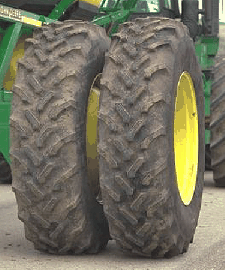 Dual tire conversion kit
Dual tire conversion kit
The rear duals conversion kit allows converting carts equipped with 20.8R-38 R1, 20.8R-42 and 18.4-26 10 PR R3 tires from single wheels to duals.
Bundle includes two wheel spacers (AA44677) for rear cart tires which will move each tire 7.75-in. from center.
Two warning light bracket extensions (left- and right-hand side) are also included.
Rear dual tire spacings
| Tires | Spacing: Centerline to centerline |
| Duals - Inner tires | 120.6 in. (3062 mm) |
| Duals - Outer tires | 176.6 in. (4485.8 mm) |
IMPORTANT: Rear duals are recommended on slopes from 10-15 degrees.
A wide choice of tires and wheels is available for field installation to match soil and residue conditions.
For more information on tire options, please see 1910 Wheel and Tire Options.
Single rear-tire spacing—all carts
Tires |
Tread spacing—centerline to centerline |
18.4-26 |
3.47 m (136.6-in.) |
23.1-26 |
3.44 m (135.6-in.) |
28L-26 |
3.44 m (135.6-in.) |
30.5L-32 |
3.44 m (135.6-in.) |
710/70R38 (code 3012) |
3.44 m(135.6-in.) |
710/70R38 (code 3010) |
3.0 m (118-in.) |
Dual rear-tire spacing—all carts
Tires |
Tread spacing—centerline to centerline |
18.4R42 |
|
Inner tire |
3.06 m (120-in.) |
Outer tire |
4.57 m (180-in.) |
20.8R38 |
|
Inner tire |
3.06 m (120-in.) |
Outer tire |
4.57 m (180-in.) |
20.8R42 |
|
Inner tire |
3.06 m (120-in.)
|
Outer tire |
4.57 m (180-in.) |
NOTES:
-
If tires are changed on the cart, the drive sprocket must match.
- Includes TWO tires and wheels and tire circumference sprockets.
A wide choice of tires and wheels is available for field installation to match soil and residue conditions.
For more information on tire options, please see 1910 Wheel and Tire Options.
Single rear-tire spacing—all carts
Tires |
Tread spacing—centerline to centerline |
18.4-26 |
3.47 m (136.6-in.) |
23.1-26 |
3.44 m (135.6-in.) |
28L-26 |
3.44 m (135.6-in.) |
30.5L-32 |
3.44 m (135.6-in.) |
710/70R38 (code 3012) |
3.44 m(135.6-in.) |
710/70R38 (code 3010) |
3.0 m (118-in.) |
Dual rear-tire spacing—all carts
Tires |
Tread spacing—centerline to centerline |
18.4R42 |
|
Inner tire |
3.06 m (120-in.) |
Outer tire |
4.57 m (180-in.) |
20.8R38 |
|
Inner tire |
3.06 m (120-in.) |
Outer tire |
4.57 m (180-in.) |
20.8R42 |
|
Inner tire |
3.06 m (120-in.)
|
Outer tire |
4.57 m (180-in.) |
NOTES:
-
If tires are changed on the cart, the drive sprocket must match.
- Includes TWO tires and wheels and tire circumference sprockets.
A wide choice of tires and wheels is available for field installation to match soil and residue conditions.
For more information on tire options, please see 1910 Wheel and Tire Options.
Single rear-tire spacing—all carts
Tires |
Tread spacing—centerline to centerline |
18.4-26 |
3.47 m (136.6-in.) |
23.1-26 |
3.44 m (135.6-in.) |
28L-26 |
3.44 m (135.6-in.) |
30.5L-32 |
3.44 m (135.6-in.) |
710/70R38 (code 3012) |
3.44 m(135.6-in.) |
710/70R38 (code 3010) |
3.0 m (118-in.) |
Dual rear-tire spacing—all carts
Tires |
Tread spacing—centerline to centerline |
18.4R42 |
|
Inner tire |
3.06 m (120-in.) |
Outer tire |
4.57 m (180-in.) |
20.8R38 |
|
Inner tire |
3.06 m (120-in.) |
Outer tire |
4.57 m (180-in.) |
20.8R42 |
|
Inner tire |
3.06 m (120-in.)
|
Outer tire |
4.57 m (180-in.) |
NOTES:
-
If tires are changed on the cart, the drive sprocket must match.
- Includes TWO tires and wheels and tire circumference sprockets.





